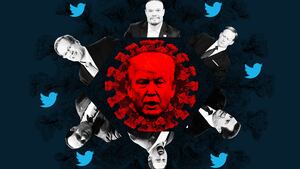The Trump administration’s response to the coronavirus crisis has been exasperating at times. He is finally taking it more seriously and setting the right tone in daily press briefings. But he’s also starting daily spats with governors on Twitter.
Any improvements in presidential behavior since Monday still mask some fundamental problems at the White House being uncovered by this crisis. This past Sunday, when photos spread across the media of U.S. citizens languishing in the customs waiting areas of airports after returning home from overseas, it was painfully clear that the White House has not done enough to build that necessary bridge between the federal government and its state and local counterparts.
On a Saturday evening, we saw Illinois Gov. J.B. Pritzker implore the White House through Twitter—the only “communication [that they] pay attention to”—to “get its s@#t together.” The anger was both palpable and necessary. The following morning, Pritzker told Meet the Press that the White House did eventually reach out to him. But it wasn’t to offer help to his constituents, it was to chastise him for his tweets.
This is a failed approach that the White House needs to correct fast. Close coordination and cooperation with state and local officials is absolutely critical in a crisis like this. I know. After 9/11, as a staffer in the White House Homeland Security Council, I was a point of contact for those officials as we coordinated our ongoing response to the threat of global terrorism.
The Bush White House team developed very close, cordial, and trusting relationships with state and local partners that transcended politics. In 2002, President Bush created the Homeland Security Advisory Council, which included Democratic officials, like D.C. Mayor Anthony Williams and former Democratic congressman Lee Hamilton, and focused on a coordinated approach across governments and the private sector. We spent a great deal of time on the road, meeting with lawmakers on both sides of the aisle to assess needs and desired federal assistance.
I fondly remember one meeting in California with Gavin Newsom, who was the mayor of San Francisco at the time. Newsom objected to then-mayor of Oakland Jerry Brown’s insertion of politics into the conversation, by noting that on the issue of terrorism, we were all on the same side. And he put those words into action by being a reliable partner to us, as we were to him.
Seeing the governor of Illinois lash out at a situation that was beyond his control—considering international airport points of entry are federal jurisdiction—demonstrated a clear lack of the close coordination necessary to have a sufficient and integrated response.
There were reportedly 11 airports taking in international travelers following President Trump’s announcement of new travel restrictions earlier in the week. That is a precise and manageable list of localities that require an open line of communication with their state and municipal leadership, especially with the expected onslaught and additional screening measures.
But that’s likely part of the problem. The White House is simply not anticipating these issues nor is it prepared for these dire conditions. Staff have not built those relationships over the years to turn them on when needed. A hyper-partisan president and a polarized nation have meant that even issues like this, which should be unifying, are divisive.
The morning after the airport disaster, the president was tweeting just like Pritzker—but his tweets, incredibly, were about Hillary Clinton’s emails. Later Trump tweeted that governors and local officials were responsible for coronavirus testing problems, which showed an extraordinary degree of hubris and inanity.
This administration has also suffered from its reliance on placing agency leaders in acting capacities to avoid confirmation hearings that would be difficult even in a Republican-led Senate. Many serve for a year and move to another position or out of the government entirely.
Both the current Secretary and Deputy Secretary of Homeland Security are “acting.” The preceding Secretary of Homeland Security held the job in an acting capacity for seven months. In the White House, there has been an unprecedented turnover in the Public Liaison and Intergovernmental Affairs offices, which are responsible for developing relationships across governments and partners.
You simply cannot lay the groundwork you need for moments like this with that personnel system in place. And the lack of basic relationships is further evidence of that challenge.
Border authorities should have begun mobilizing resources and support weeks ago for this crisis. Knowing that additional screening measures would be in place and a bottleneck of travelers was coming, they should have sought additional facilities at the airports, added staff, and taken appropriate measures to keep people as distanced as possible from one another. Imagine you’re returning from New Zealand (six cases) and forced into a confined space with someone returning from Spain (6,400 cases) for more than five hours.
Even if mistakes happen, there has to be a protocol in place to recognize and respond to it quickly. And that begins with reaching out to officials on the ground and offering and seeking assistance. Perhaps a phone call to the Illinois governor’s office on Saturday morning could have freed up additional screening space at O’Hare Airport or marshaled personnel to help manage the residents.
President Trump has had a very fortunate three years in office, with a strong economy and a limited number of national and homeland security events. But when disasters have struck, he has been seen as ill-fitted to the circumstances, like the hurricane and earthquakes in Puerto Rico.
It’s time to step it up. The White House needs to project urgency, unity, and coordination across the federal government. The polling is clear. Americans are divided and their approval of the government’s handling of the crisis largely falls on party lines. The White House needs to demonstrate broader and steadier leadership and set politics aside. Bring Democrats into the process, especially governors, and share ownership. Build partners, not critics.
We have a long way to go. Due to the earlier and inexcusable testing failures, we are likely to see numbers spike as more symptomatic people are tested. That will mean more challenges, more isolation, more closings, more economic problems, and more tests of our national responsiveness. A quickly-drafted stimulus bill in Congress won’t solve all of these problems. As President Trump is about to find out, throwing cash at an issue doesn’t always fix everything.







